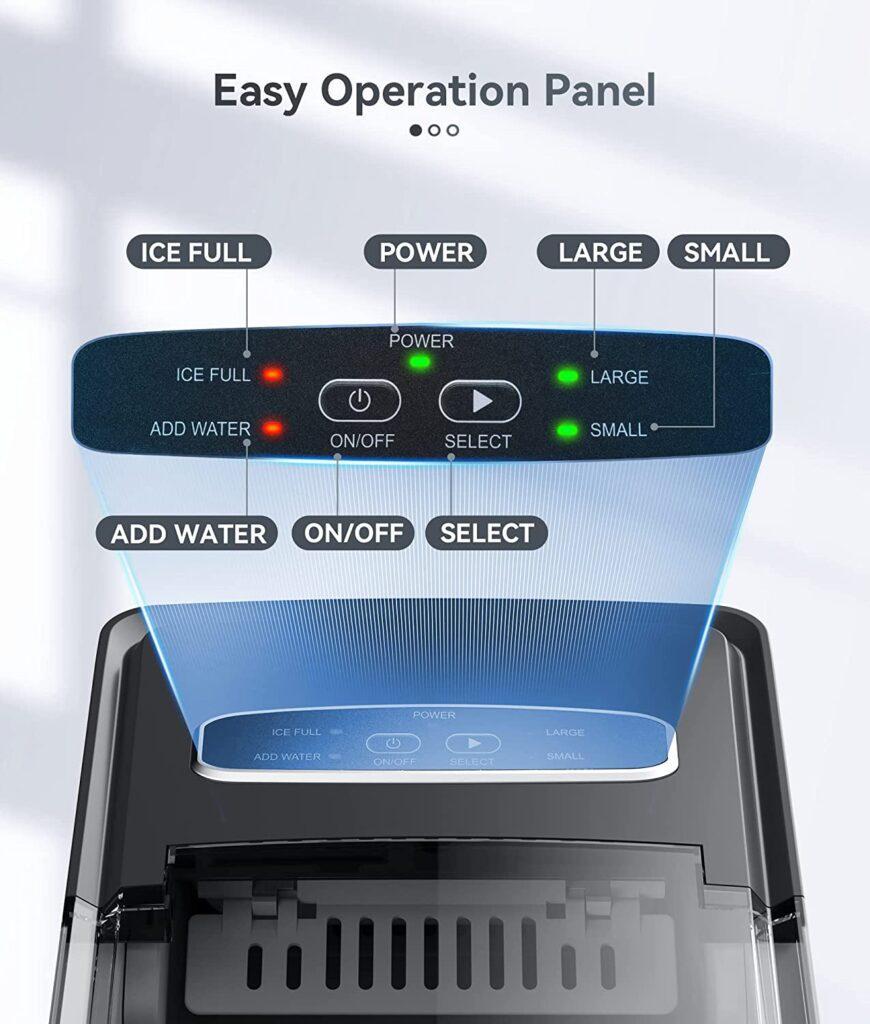How Long Does It Take to Make Ice in Portable Ice Maker?
Portable ice machines make ice within a short period. You’re able to get 26 to 35lbs of ice in a day.
It takes approximately 7 to 15 minutes for the machine to make a batch of ice. The speed depends on the machine type, size, and shape of the ice being made.
For small and medium-sized cubes, it takes about 7 minutes and doubles that for large ice.
An ice maker with a 26lbs daily capacity produces about 9 pieces of ice in a cycle while a 40lbs capacity makes 24 pieces in a single cycle.
With this information, you have a rough idea of what to expect from your machine.

For some Euhomy ice-maker machines, you can adjust the ice-making duration. They have + and – buttons on the control panel.
How Do Portable Ice Machines Work
A portable ice machine works in several steps. You initiate the first process by opening the cover. This is to remove the ice basket and add water to the reservoir.
Before proceeding, ensure that the water doesn’t exceed the indicated level and that the ice basket is secure.
The next step is to plug in and power the machine. Press the on/off button and select the size of ice small (S) or large (L).
The water pump starts by pumping water from the reservoir/storage tank to the water box.
Once the water box is full, the evaporator rods move down and dip into the water. The rods get cold and start freezing the water.
This process is carried out by the compressor.
Once the ice is formed on the rods dependent on the size selected, the thermostat detects the temperature and sends a signal.
The rods then heat up to melt the formed ice and it falls.
Any water left in the water box is moved back to the reservoir. This happens by the tilting of the water box.
The ice pusher then swings into action to move the ice to the ice basket. The ice is now ready for use.
A new cycle then begins after this process.
Read: What To Look for When Buying a Portable Ice Maker
How Often Should Ice Maker Drop Ice?
The ice maker should drop ice after the end of every ice-making cycle. This takes about 15 minutes for large cube sizes.
The ice pusher moves the ice dropped from the evaporator rods to the ice basket.
A countertop ice maker follows a step-by-step process when making ice. One action proceeds the other, the process does not continue if one element is missing.
For example, the ice maker rods/evaporator fingers do not move into the water to freeze ice until the water is pumped from the storage tank/reservoir to the water box/tray.
The settings are in place to ensure the efficient operation of the machine. Keeping an eye on the control panel gives a good indication of the processes taking place.
There are warning indicators when the reservoir is empty or when the water is running low. The safeguards set up minimize accidental damage keeping you and your home safe.
Read: Is A Portable Ice Maker Worth It?
How Does a Countertop Ice Maker Know When to Dump the Ice?
Countertop ice makers feature a fully automatic control system with an advanced microcomputer that facilitates ice-making. An electrical signal is sent between the appliance components to make things work.
When the rods are making the ice, a thermostat is alert. It detects the temperature of the cubes. Once the temperature reaches about 6 to 15 Fahrenheit, a signal is sent for the ice to drop.
The manufacturers set specific temperature thresholds depending on the ice size. This is to ensure the mold formed is frozen as required.
In most models, you’ll find an ice selection option on the control panel. You’re able to choose between large and small ice sizes.
How Does an Ice Maker Know When It’s full?
The ice basket has a limited storage capacity compared to the production capacity of the machine. Even though it is not full after one ice-making cycle, you’ll need to remove the ice.
The ice maker knows when it is full using the temperature sensor. As the ice collects in the basket, it reaches a certain capacity that alerts the temperature sensor.
A signal is then sent that stops the ice-making process and the machine indicates it is full on the control panel. The temperature sensor should always be above the ice for the process to continue.
Check out: How Often Should You Clean Your Portable Ice Maker?
Can I Leave My Countertop Ice Maker on All the Time?
As mentioned before, countertop ice maker machines have an automatic control system.
Yes, you can leave the ice maker on all the time if you need ice produced. You only need to ensure there is water in the reservoir and the ice basket is emptied when full.
Also remember, if you leave the machine running without managing the ice made, it will melt and water will flow back to the reservoir. You’ll end up using up more power.
It’s not recommended to let the machine stay idle and plugged in. Make as much ice as you need, store and turn the machine off.
Conclusion
Ice maker machines make small and large size ice. The time it takes a countertop ice maker to make ice is dependent on the size chosen.
On average, it takes between 7 to 15 minutes for a complete cycle. A machine producing 26 pounds of ice a day gives about 9 ice pieces per cycle.
Countertop ice machines have a fully automatic system that makes the process efficient. One process initiates the next one when complete.
For the ice-making process to start, the reservoir needs to have water. The water is then pumped into the water box where freezing occurs.
Once the evaporator rods have attained a specific temperature to make the chosen ice shape, the thermostat sends a signal.
The signal communicates that it’s time to release the ice. Water left in the water box is drained and the ice is moved to the ice basket.
The process is straightforward. Some machines allow you to adjust the time it takes to make ice if feel that it’s taking longer than necessary.

